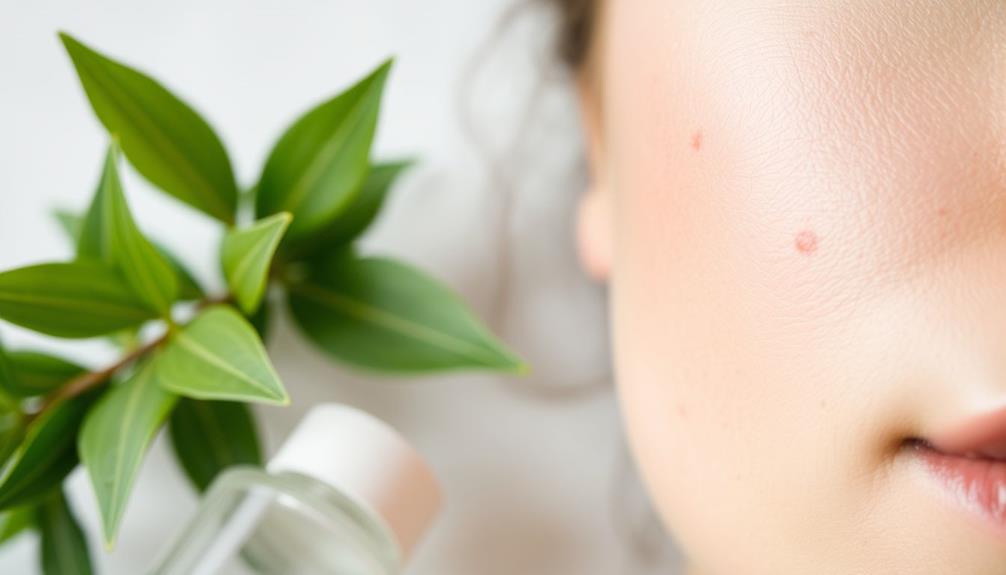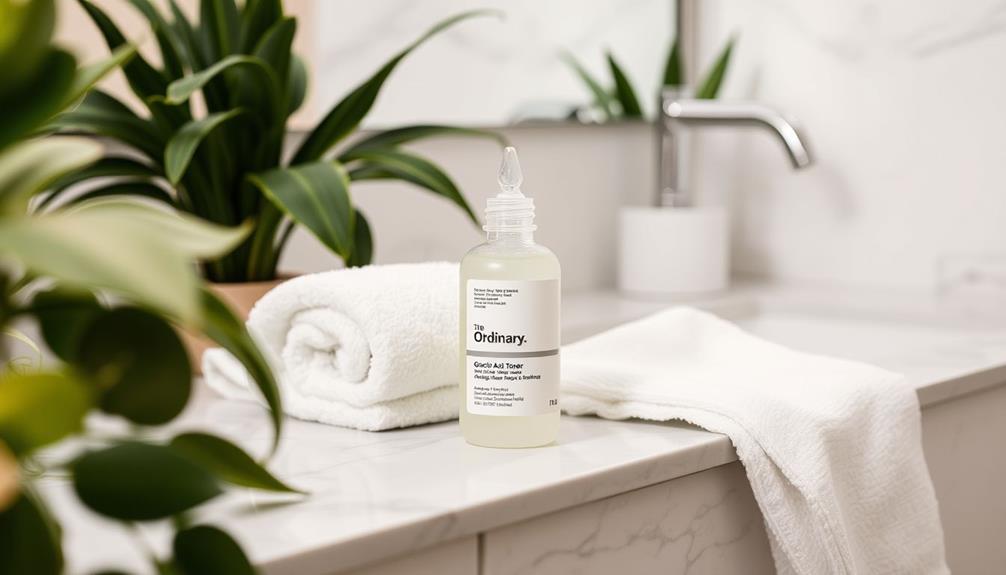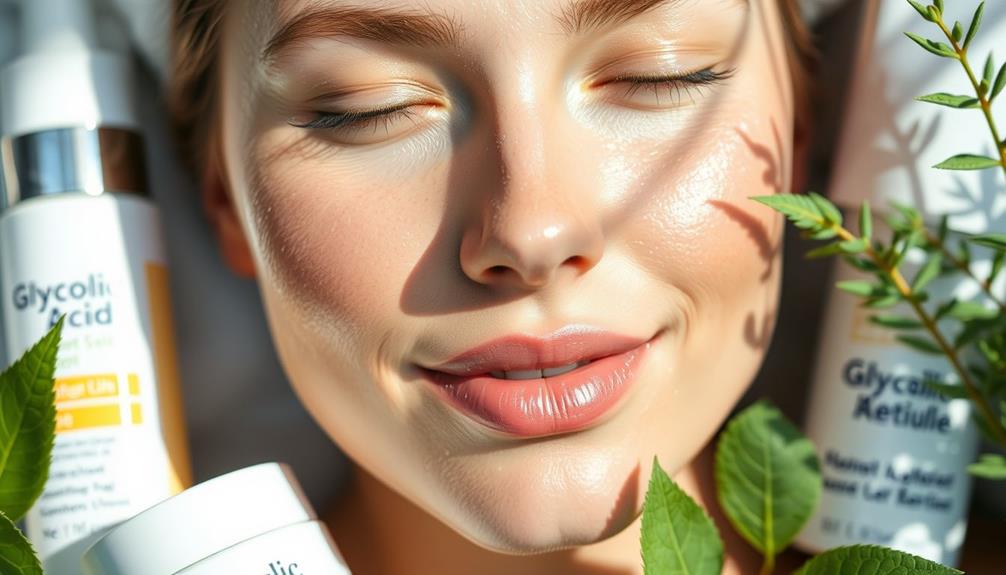Glycolic acid fades dark spots by reducing excess melanin production and enhancing cell turnover. This gentle exfoliant helps clear away dead skin cells, revealing brighter skin underneath. As you use it regularly, you'll notice an even skin tone and a reduction in hyperpigmentation. Typically, you can expect visible improvements within a few weeks, with significant fading over time. Start with lower concentrations to see how your skin reacts, applying it in the evening to minimize sensitivity. Consistency is key to achieving the best results, and there's much more to explore on how to maximize its effectiveness.
Key Takeaways
- Glycolic acid reduces dark spots by inhibiting melanin production and promoting cell turnover for a brighter complexion.
- Regular application of glycolic acid enhances skin texture, evens tone, and fades hyperpigmentation over time.
- Start with lower concentrations and gradually increase frequency to improve skin tolerance and effectiveness.
- Pair glycolic acid with sun protection and moisturizing products to optimize results and maintain skin hydration.
Causes of Dark Spots
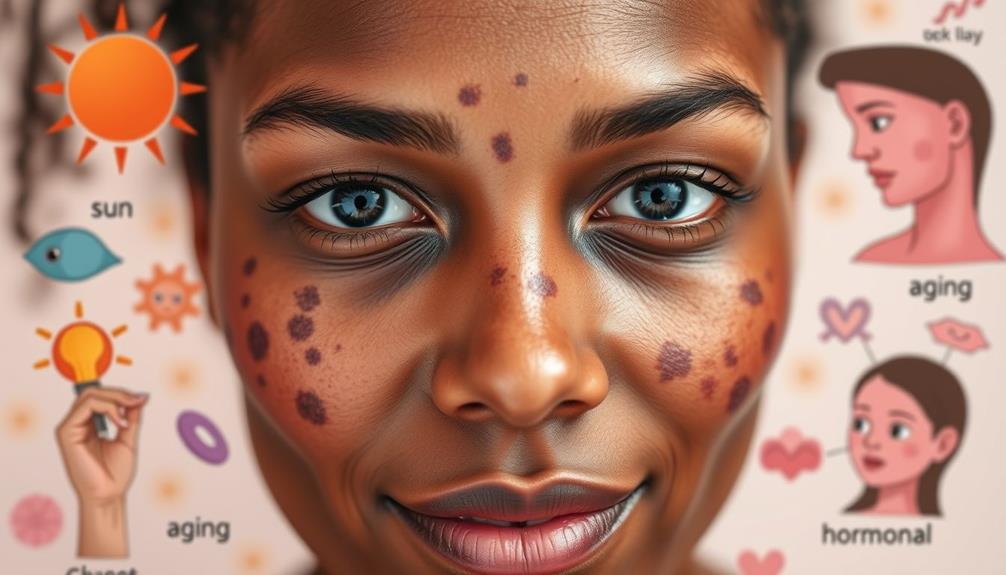
What causes dark spots on your skin?
Dark spots, also known as hyperpigmentation, can result from various factors, with increased melanin production being the primary culprit.
Sun damage plays a significant role; when your skin is exposed to ultraviolet (UV) rays, it produces excess melanin, leading to age spots or sunspots. If you've ever noticed darker patches after spending time outdoors, this is likely the reason.
Additionally, certain essential oils, like lavender, may help support skin health and promote an even skin tone through their therapeutic properties aromatherapy benefits.
Another common cause is post-acne marks, which appear as your skin heals from inflammation. These localized areas of darker pigmentation can linger long after the acne itself has faded.
Additionally, environmental factors such as pollution can accelerate melanin production, resulting in further skin discoloration.
Hormonal changes can also contribute to dark spots, particularly in women. During pregnancy, for instance, some experience melasma, characterized by brown or gray-brown patches on the skin.
Understanding these causes is vital for addressing dark spots effectively, so you're better equipped to take action and seek appropriate treatments.
Benefits of Glycolic Acid

Glycolic acid offers impressive benefits for your skin, especially when it comes to reducing dark spots and improving texture.
In addition to its effectiveness in tackling melanin overproduction, the use of essential oils can also enhance your skincare routine, providing natural alternatives to synthetic fragrances that promote overall well-being.
You'll notice a more even skin tone as it tackles melanin overproduction and helps clear clogged pores.
Regular use can lead to a smoother, more radiant complexion that feels youthful and refreshed.
Dark Spot Reduction
When you're looking to fade dark spots, incorporating glycolic acid into your skincare routine can make a noticeable difference over time. This powerful ingredient works by interrupting melanin overproduction, which is a major cause of hyperpigmentation.
Regular use of glycolic acid can lead to a more even skin tone, with initial improvements often visible within just a few weeks. Additionally, maintaining a clean indoor environment using air purifiers can help reduce allergens that may exacerbate skin issues.
By exfoliating the top layer of your skin, glycolic acid helps remove dead skin cells and excess melanin that contribute to dark spots. Many users report significant reductions in dark spots after consistent application, making it an effective option for tackling this common concern.
For best results, aim to use glycolic acid treatments 2-4 nights per week. Don't forget to apply a broad-spectrum sunscreen during the day to protect your newly exposed skin from harmful UV rays.
This combination won't only enhance the fading process but also prevent new dark spots from forming. With dedication to your skincare routine, you'll likely see a more radiant and even complexion as glycolic acid works its magic on dark spots.
Skin Texture Improvement
Exfoliating with glycolic acid markedly improves skin texture, leaving you with a smoother and more radiant complexion. This powerful ingredient works by effectively removing dead skin cells, which not only enhances your skin's appearance but also addresses pigmentation issues like dark spots. By unclogging pores and reducing roughness, glycolic acid helps prevent future breakouts, making it an essential part of your skin care routine.
Regular use supports collagen production, firming the skin and reducing fine lines. Many users have reported noticeable improvements in skin texture within just a few weeks, with an impressive average rating of 4.5 out of 5 for its effectiveness.
Here's a quick overview of the benefits of glycolic acid:
| Benefit | Description | Result |
|---|---|---|
| Exfoliation | Removes dead skin cells | Smoother texture |
| Blackhead Clearing | Unclogs pores | Fewer breakouts |
| Collagen Support | Promotes collagen production | Firmer skin |
| Dark Spot Reduction | Targets pigmentation issues | Lighter dark spots |
| Quick Results | Visible changes in weeks | Improved overall texture |
Incorporating glycolic acid into your skincare routine can transform your skin texture and help tackle those stubborn dark spots.
How Glycolic Acid Works
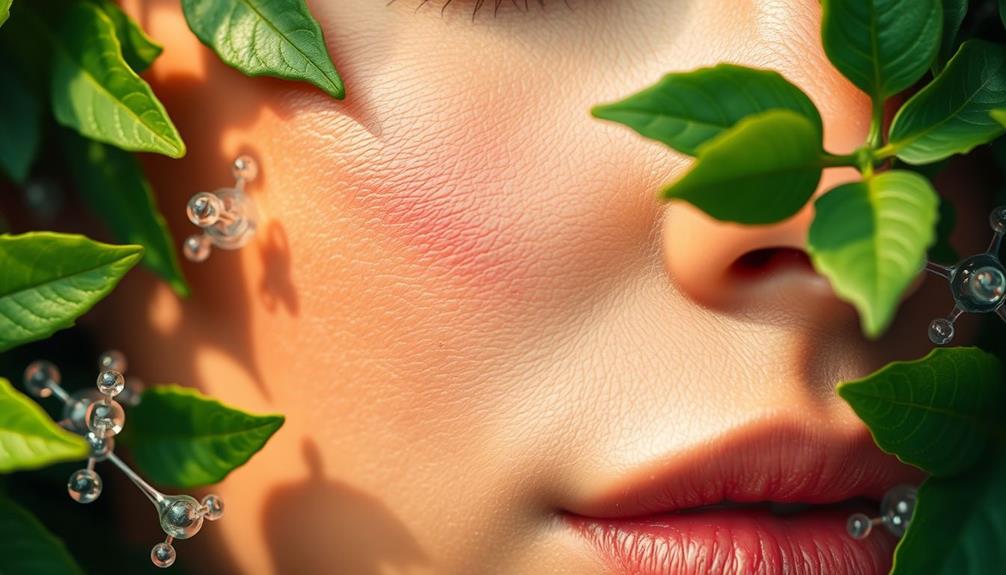
This powerful alpha-hydroxy acid boosts cell turnover by breaking down the bonds between dead skin cells, helping you disclose fresher, more radiant skin.
Glycolic acid effectively targets dark spots and hyperpigmentation by inhibiting melanin production in those affected areas. As you use it regularly, you'll notice a more even skin tone, bringing out your natural beauty. The exfoliating properties of glycolic acid also help to remove dead skin cells and promote cell turnover, further improving the appearance of dark spots and hyperpigmentation. This ingredient has the ability to penetrate deep into the skin, making its impact on pigmentation more effective. The overall impact of glycolic acid on the skin is a brighter, more radiant complexion with diminished dark spots and a more even tone.
Additionally, glycolic acid enhances the penetration of other active ingredients in your skincare routine, making them more effective. This means that not only are you treating existing dark spots, but you're also maximizing the benefits of your entire regimen.
Another key benefit is its ability to attract moisture to your skin. As you hydrate, you're also stimulating collagen production, which contributes to a firmer texture and a youthful glow.
Over time, consistent use of glycolic acid can lead to significant reductions in hyperpigmentation, revealing a smoother complexion.
Timeframe for Visible Results
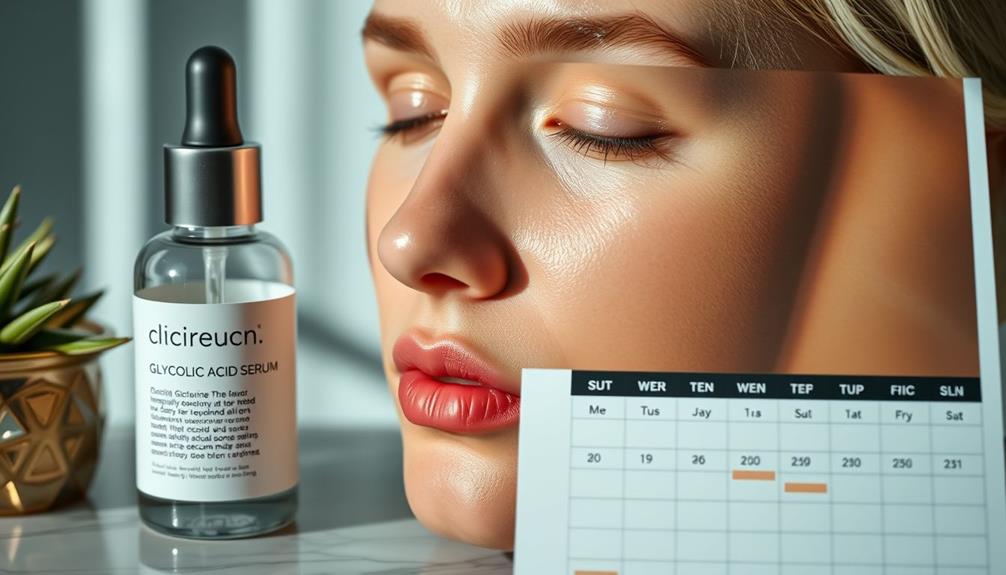
Visible results from glycolic acid often start to emerge within just a few weeks of regular use, revealing improvements in skin texture and tone.
When it comes to dark spots, you can expect noticeable fading with consistent application. However, the timeframe for visible improvements varies from person to person, depending on your skin type and the severity of the hyperpigmentation.
Typically, initial benefits may show up in a few weeks, but significant fading of dark spots often requires several weeks to months.
For best results, you should stick to a regular routine; this consistency is key to enhancing the effectiveness of glycolic acid.
In some cases, it might take up to three months to fully manifest long-term effects, especially for those concerned with anti-aging and persistent pigmentation issues.
Application Guidelines
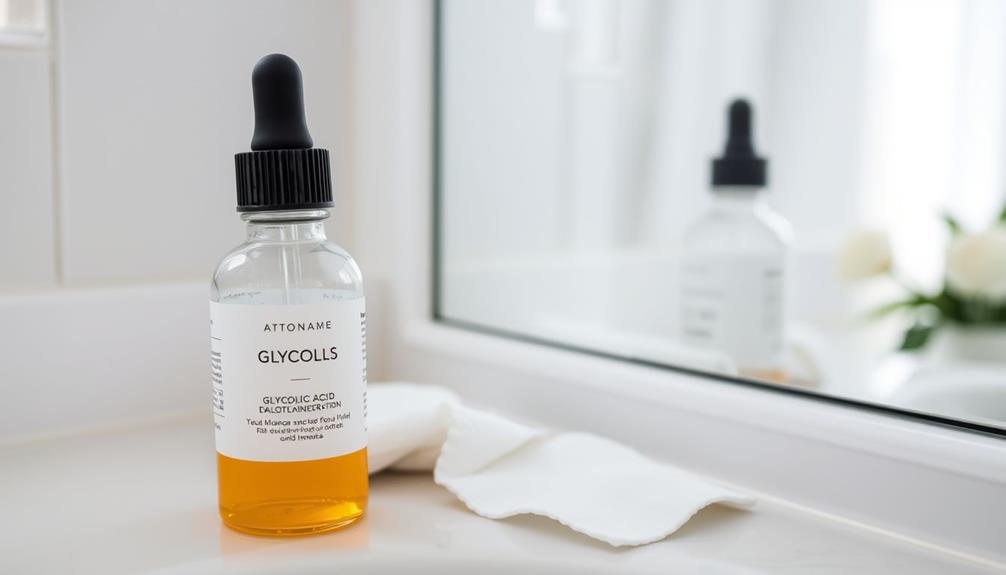
When using glycolic acid, start with a lower concentration and limit your application to 1-3 times a week to gauge how your skin reacts.
It's best to apply it in the evening on clean skin and follow up with a moisturizer.
As you build tolerance, you can gradually increase the frequency for ideal results.
Frequency of Use
To achieve the best results with glycolic acid, apply it 2-4 times a week and adjust based on how your skin reacts.
If you have sensitive skin, start with lower concentrations of around 5-10% to minimize irritation. This way, you can still enjoy the exfoliating benefits while your skin gets accustomed to the treatment.
It's vital to apply glycolic acid products in the evening. This timing reduces the risk of sun sensitivity and lets the acid work its magic overnight. After applying glycolic acid, always follow up with a broad-spectrum sunscreen during the day. This protects your treated skin from UV damage, which is essential for fading dark spots effectively.
Monitor your skin's reaction closely. If you notice any irritation, reduce the frequency of use. Conversely, if your skin tolerates it well, you can gradually increase application.
Consistency is key; regular use leads to more noticeable improvements in reducing dark spots over time. Remember, everyone's skin is unique, so find the right balance that works for you.
Application Techniques
Proper application techniques can enhance the effectiveness of glycolic acid in fading dark spots while minimizing irritation.
Start with a lower concentration of glycolic acid, around 5-10%, to see how your skin reacts. This is especially important if you have sensitive skin.
Apply glycolic acid products in the evening to reduce the risk of sun exposure, as they can make your skin more vulnerable to UV rays.
Initially, use glycolic acid 2-3 times per week. Gradually increase the frequency based on your skin's response and tolerance.
After applying glycolic acid, always follow up with a broad-spectrum sunscreen during the day. This step is essential to protect your treated skin from potential UV damage.
To support your skin barrier and alleviate dryness, consider pairing glycolic acid with hydrating products like ceramide-containing moisturizers. This can help maintain moisture levels while you work on fading those dark spots.
Combining Ingredients Safely
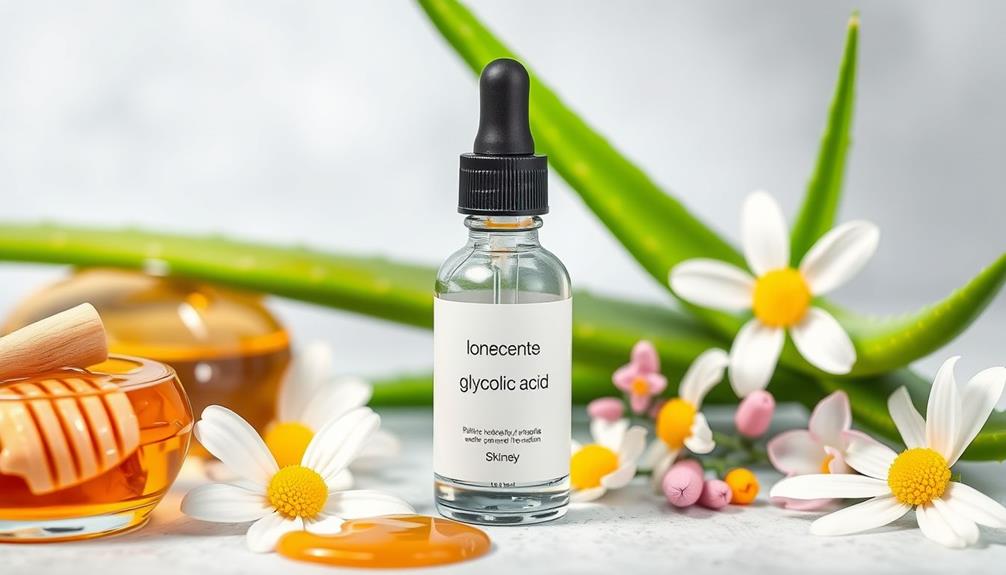
Combining glycolic acid with other ingredients requires careful consideration to avoid irritation and maximize benefits. When you're formulating your skincare routine, it's essential to know which combinations work well together. Here's a quick guide to help you navigate the process:
| Ingredient | Can Be Combined? | Notes |
|---|---|---|
| Lactic Acid | Yes | Enhances effects without irritation. |
| Retinol | No | Space out usage to reduce irritation. |
| Vitamin C | Yes | Boosts brightening effects for dark spots. |
Start with lower concentrations of glycolic acid (5-10%) and limit its use to 1-3 times per week, gradually increasing as your skin adapts. Avoid pairing glycolic acid with other AHAs and BHAs to minimize the risk of irritation. After application, follow up with a moisturizer containing ceramides to maintain your skin barrier. Combining glycolic acid with brightening agents like vitamin C can greatly enhance your skincare routine, making it more effective in fading dark spots. Always listen to your skin and adjust your regimen accordingly.
Recommended Glycolic Acid Products
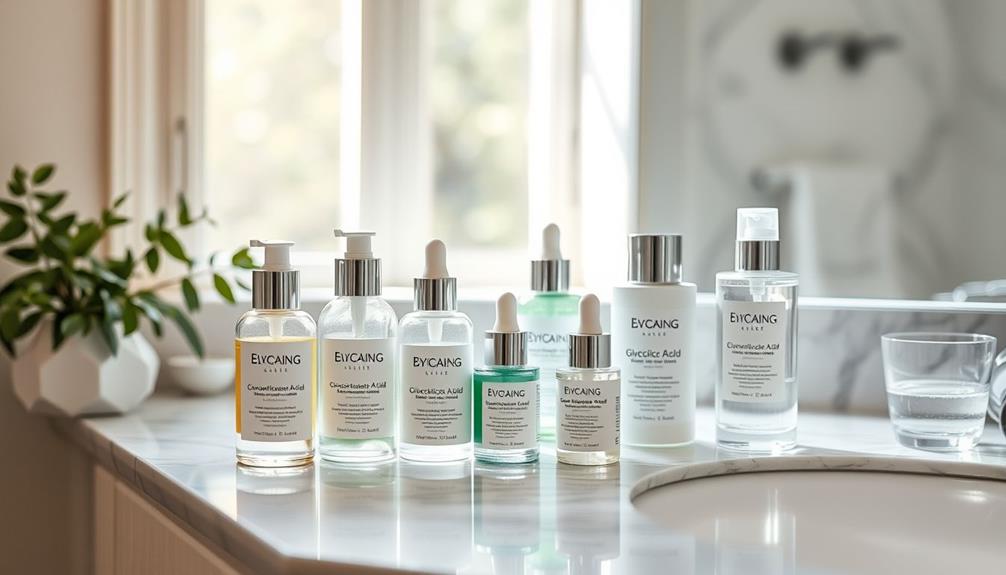
Several effective glycolic acid products are available that can help you combat dark spots and improve your skin's overall texture.
Start with glycolic acid toners, which balance your skin's pH and prepare it for further treatment. For cleansing, consider glycolic acid cleansers that exfoliate while they cleanse, leaving your skin fresh and radiant.
If you're looking for an intensive treatment, the 10% Glycolic Acid Crème specifically targets uneven skin tone and enhances overall texture. For body care, the Lactic Acid + Glycolic Acid Body Lotion combines hydration with exfoliation, effectively addressing roughness and dark spots.
Dark Spot Brightening Serums often contain concentrated glycolic acid along with other active ingredients, making them perfect for targeting hyperpigmentation and melasma, resulting in a brighter and more even complexion.
When choosing glycolic acid products, it's best to start with lower concentrations of around 5-10% if you have sensitive skin. This approach minimizes irritation while allowing you to gradually increase frequency as tolerated.
Always remember, consistency is key to seeing results in reducing dark spots and improving your skin's appearance.
Professional Treatments and Efficacy
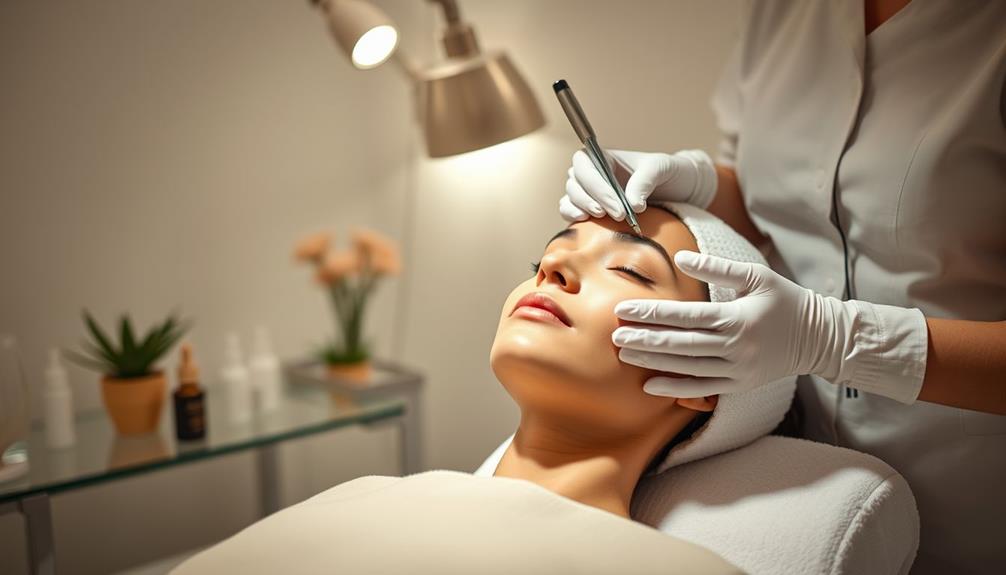
Professional treatments with glycolic acid, like chemical peels, deliver stronger results in fading dark spots and evening out skin tone. These treatments typically use higher concentrations of glycolic acid (20-30%), which can greatly improve hyperpigmentation after just a few sessions. Many people see visible changes within 4 to 6 weeks, making them an efficient choice for those serious about addressing skin concerns.
Incorporating other active ingredients, like retinoids or vitamin C, during these professional treatments can create a synergistic effect, enhancing the overall results. Not only do these treatments help fade dark spots, but they also stimulate collagen production, leading to improved skin texture and firmness.
Dermatologists often recommend a series of professional glycolic acid treatments, followed by a consistent regimen of at-home glycolic acid products. This approach helps sustain the fading of dark spots and promotes a brighter, more radiant complexion.
Tips for a Successful Routine
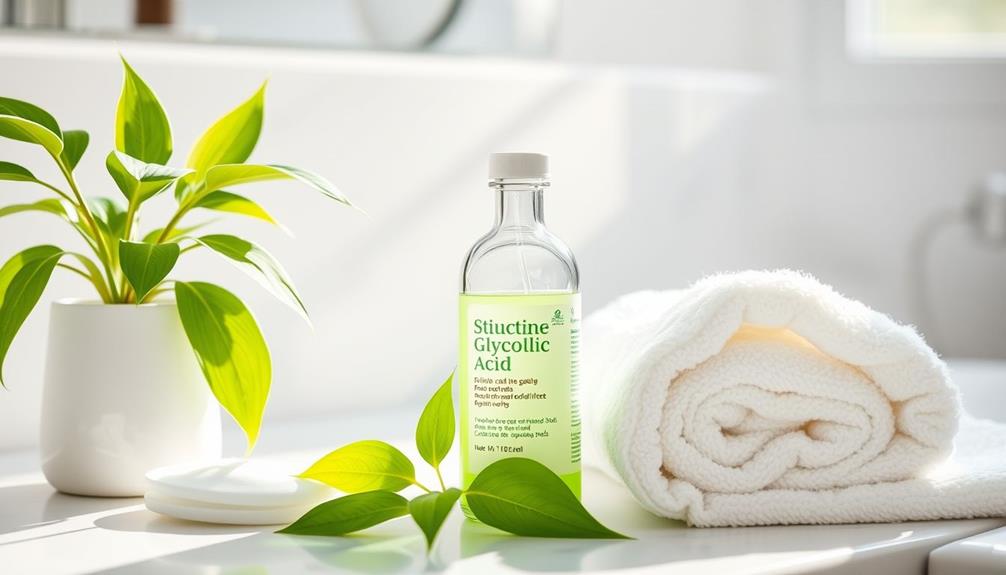
To achieve the best results with glycolic acid, start by incorporating it gradually into your skincare routine.
If you have sensitive skin, begin with a lower concentration of around 5-10%. This helps you assess your skin's tolerance while targeting those dark spots effectively.
Apply glycolic acid products at night to minimize UV sensitivity, and don't forget to use a broad-spectrum sunscreen with SPF 30 or higher during the day.
For ideal results, use glycolic acid 2-4 nights per week, gradually increasing the frequency as your skin adjusts. Monitor how your skin responds; if you experience irritation, reduce usage or concentration until your skin condition improves.
Combining glycolic acid with hydrating products, like ceramide-rich moisturizers, can also help mitigate dryness or irritation from exfoliation.
Remember, the benefits of glycolic acid include promoting cell turnover and brightening your complexion, making it a powerful ally against dark spots.
Frequently Asked Questions
How Long Does It Take Glycolic Acid to Fade Dark Spots?
Glycolic acid can start fading dark spots within a few weeks, but noticeable improvements generally take several months. Regular application, about 2-4 nights a week, is key for achieving the best results over time.
Does Glycolic Acid Remove Dark Spots Permanently?
Glycolic acid works like a garden tool, pruning away dark spots, but it doesn't provide permanent results. You'll need to keep using it regularly to maintain that brighter, more even skin tone you desire.
How to Know if Glycolic Acid Is Working?
You'll know glycolic acid is working when you notice your skin's texture improving, dark spots fading, and fewer breakouts. Consistent use, typically 2-4 nights a week, helps you track these positive changes effectively.
Why Is My Skin Getting Darker After Using Glycolic Acid?
If your skin's getting darker after using glycolic acid, it could be due to irritation or overuse. Start with lower concentrations, and make certain you're protecting your skin from the sun to minimize adverse reactions.
Conclusion
Incorporating glycolic acid into your skincare routine can be a game-changer for fading dark spots.
Did you know that over 90% of people experience some form of hyperpigmentation in their lifetime?
With consistent use and patience, you'll likely see visible results within a few weeks.
Just remember to follow application guidelines and combine ingredients safely.
Embrace your journey to clearer skin, and don't hesitate to consult a professional if you need extra guidance.
You've got this!
